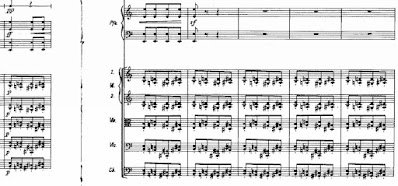CCXCI. BARTÓK, Béla (1881-1945)
Bartók's early works are all over the place, stylistically. Around this time, he became enamoured of the use of tight clusters by the tragically underappreciated Henry Cowell (see Post XCVIII).
His pianistic technique was extraordinary, and he set out to write compositions which would showcase his playing.
Here, he basically uses the piano as a percussion instrument (the piano is considered a member of the percussion family!) ... and the music is -- in turn -- violent, dissonant, and then lyrical and bubbling.
The public hated it.
But the composer was never deterred, and in this piece one can hear the seeds of the incredible middle quartets [see Posts LVII (3) and V (4)] and even late works like the Concerto for Orchestra (see Post CV).
First Movement
Opening with pedal-tone B's, note the cluster introduced in Bar 7:
Another notable Bartók trait is the use of off-beat stretto, like the circled example:
and pounding Stravinsky-like off-beats:
sweeping glissandi:
The movement ends with a characteristic bang:
Second Movement
Things calm down, but the percussive timbre is still predominant:
and the piano part is full of sweeping flourishes:
and for bars, the piano acts as a black-keyed drum:
The movement ends with glissandi in the trombones and piano:
and attaccas into the final movement:
Third Movement
A long series of bouncing 1/8th-notes:
to an extremely virtuoistic piano part:








_Page_46.jpeg)








No comments:
Post a Comment